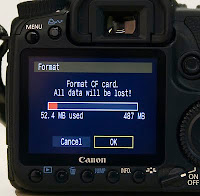But the problem turned out to be a common one: she believed her 100mm Macro lens was usable only for intraoral shots, and nothing else. Her Canon Rebel, as is often the case, came with an 18-55mm general-purpose zoom lens, and she was using this for her portrait shots. This is a good lens for a lot of things, but portraits is not among them. The reason? This zoom lens is very "short" (i.e., wide-angle) and while scenics are great, portraits are distorted, and it was this distortion that caused the images to look disappointing. Let's look closely at this:
This is how a full-face shot will look when you use that zoom lens (or any similar lens that comes with your camera). In this case, the zoom focal length was set on 18mm, its widest setting. Notice how greatly distorted it looks. In fact, to get the face to fully fill the frame, I had to shoot about 2 or 3 inches away from her nose. Obviously un-usable.
For this next one, I set that zoom lens to its 35mm focal length, so I wouldn't have to stand so close to her. It's an improvement, but not by very much. It still looks much too distorted.
When the lens is set at 55mm focal length, its longest, the image starts to look more appealing. Although there is much less distortion, it's still there.
But here, with the 100mm Macro lens, the portrait looks excellent. There's none of the distortion caused by using the shorter zoom lens. In fact, outside the opertory, this very same Macro lens is an excellent one for many kinds of photographic projects. It's wonderfully sharp and fast. So take it outside and have fun with it. After all, of all the tools you use in your practice, your camera is the only one you can say that about!





































